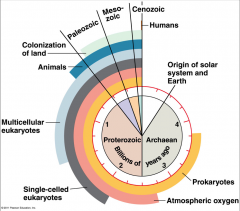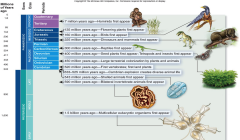![]()
![]()
![]()
Use LEFT and RIGHT arrow keys to navigate between flashcards;
Use UP and DOWN arrow keys to flip the card;
H to show hint;
A reads text to speech;
50 Cards in this Set
- Front
- Back
|
origin of solar system and earth date |
about 4.6 bya |
|
|
when did the first living organisms appear? |
3.5-4 bya (either prokaryotes or archaea) |
|
|
what are the 6 requirements for life? |
1. cells & organization 2. energy use & motabolism 3. regulation & homeostasis 4. growth & development 5. reproduction 6. biological evolution |
|
|
how is it hypothesized that life originated? |
in four, overlapping stages...
1. nucleotides and amino acids were produced before the existence of cells 2. they were then polymerized into larger molecules 3. those polymers became enclosed in membranes 4. those enclosed polymers acquired cellular properties |
|
|
stage 1: nucleotides and amino acids were produced before the existence of cells |
primitive earth may have been more conducive to spontaneous cellular creation, 3 hypotheses on how it was created
earth had very little O2 in this stage |
|
|
prebiotic soup |
a slow accumulation of molecules in the earth's oceans over a long period of time, helping the spontaneous formation of early cells |
|
|
reducing atmosphere hypothesis |
the early atmosphere contained methane and ammonia, which are easily reducible (to give up electrons)
Stanley Miller created a simulation of this, created > 20 A.A. |
|
|
extraterrestrial hypothesis |
carbonaceous chordite meteorites may contain a lot of organic material and hit earth
problems: the heat on impact would kill all organic material |
|
|
deep sea hypothesis |
molecules may have formed in the temperature gradient between the hot vent and cold ocean water
many communities still reside around these vents |
|
|
current belief on where life officially originated |
in the oceans |
|
|
hydrolosis |
breaking down polymers |
|
|
stage 2: polymerization into larger molecules |
amino acids polymerized into proteins
have been tested and proven that polymers can form on clay or near hydrothermal vents in water |
|
|
why are prebiotic synthesis of molecules hard in aqueous solutions? |
because hydrolysis is also occurring and competing, which will break down polymers
this is how scientists argue that it may not have occurred in a watery prebiotic soup |
|
|
stage 3: polymers became enclosed in membranes |
a formation of a boundary that separated internal polymers (like RNA) from the environment, forming a protobiont |
|
|
protobiont |
pre-biotically produced molecules that acquired a boundary that allowed it to maintain a new a different internal environment |
|
|
hypothesis of how protobionts could have formed |
on clay, it can catalyze the formation of liposomes (which is a protobiont) that grow and divide
and if RNA is present on the clay surface, then liposomes can enclose it |
|
|
4 characteristics that make protobionts possible precursors for living cells? |
1. a boundary that separates the internal contents from the external environment
2. polymers inside the protobiont contained information (like RNA)
3. polymers inside the protobiont had catalytic functions (like RNA)
4. the protobionts eventually developed the capability of self-replication (RNA couldn't replicate, but could divide at this point) |
|
|
coacervates |
coined by Alexander Oparin
hypothesis that living cells evolved from droplets that formed spontaneously from the association of charged polymers |
|
|
liposomes |
vesicles surrounded by a lipid bilayer |
|
|
stage 4: enclosed polymers began to acquire cellular properties |
only stage that lacks experimental evidence
may have happened through chemical selection
two methods: reproduction and simple metabolism |
|
|
3 functions of RNA that make it the likely candidate |
1. can store info 2. can self-replicate 3. has enzymatic functions; like ribosomes (can catalyze)
DNA and protein cannot do all 3 |
|
|
chemical selection |
how RNA mutated twice, each time becoming more favored and abundant
|
|
|
first chemical selection stage |
mutates in order to have the catalytic ability to synthesize new RNA using pre-existing RNA as templates
increases because it can now self-replicate faster |
|
|
second chemical selection stage |
mutates to now have the ability to synthesize ribonucleotides
also favored, so now the protobionts have two new abilities: self-replication and ribonucleotide synthesis |
|
|
how DNA and protein came about |
to relieve RNA of some of its duties
DNA is more stable through its double helix so it began storing info (also suffers less mutations)
proteins have more variety (20 A.A) and have a greater catalytic potential and efficiency to perform other tasks |
|
|
fossils |
preserved remains of past life on earth, can take many forms (not just bones) |
|
|
paleontologists |
scientists who study fossils |
|
|
where are fossils best found/formed |
in sedimentary rock, in the ocean
the organisms are typically buried quickly and have all their hard parts replaced by minerals
the deeper the layer, the older it is
sometimes layers can flip |
|
|
factors effecting the availability and ability of organisms to fossilize |
1. anatomy: harder body parts fossilize better 2. size: larger organisms are more likely to be found 3. number: the larger pop size over a greater area is more likely to be found 4. environment: water species more likely to be found than inland because sedimentary rock forms better in water 5. time: the more recent the fossil, the more likely it is to be found 6. geology: some organisms will be fossilized better due to their chemistry 7. paleontology: some fossils are more favored and interesting to paleontologists and therefore more likely to be found |
|
|
half life |
time it takes for 1/2 of an isotope to decay, measures the decay product of a given isotope |
|
|
major environmental changes that have occurred on earth |
1. climate/temperature 2. atmosphere composition 3. landmass shifting 4. floods and glaciations 5. volcanic eruptions 6. meteorite impacts
- any of these can cause a change in environment and give extinction/rise to organisms depending on how they can favor the new enviroment |
|
|
how organisms have changed over time |
due to genetic and environmental changes |
|
|
first known fossils |
3.5 bya |
|
|
first prokaryotes |
3.5-4 bya
they were anaerobic; unsure if hetero or autotrophs
bacteria and archaee |
|
|
heterotrophs |
get energy through the consumption of other organisms (organic molecules) |
|
|
autotrophs |
get energy from light or inorganic molecules |
|
|
stromatolite |
cyanobacteria fossils, layered calcium carbonate
they allowed the evolution for aerobic species
they were preserved when heterotrophs weren't, due to water environment
can photosynthesize without chloroplasts |
|
|
eukaryotes |
arose 2 bya
from union of 2 prokaryotes (bacteria and archaea)
endosymbiont theory
when joined with cyanobacteria, the formation of chloroplasts occurred |
|
|
endosymbiosis |
a smaller organism (the endosymbiont) lives inside a larger organism (the host) |
|
|
bacterium and archaea relationship to form double membrane |
the archaea was the host while the bacterium was the endosymbiont and entered the archaea
this resulted in the mitochondria
|
|
|
multicellular eukaryotes |
arose 1.5 bya |
|
|
1st multicellular animals |
1 bya
they were invertebrates that had bilateral symmetry (had a head and ass, along with two sides) |
|
|
cambrian explosion |
where the large increase of animal species diversity occurred (500 mya)
no major reorganization of body plans for the eukary
land plants first, animals second (food source and habitat needed)
|
|
|
hypotheses behind cambrian explosion |
start of shell evolution
more oxygen and ozone in atmosphere, favoring eukaryotes
an "arms race" between species occurred, evolving appropriately to survive |
|
|
extinctions... |
occur throughout every era; what survives before and after each extinction become different |
|
|
mass extinctions |
result from a large change in environment, resulting in major shift of dominant species group
mesozioc -> dinosaurs extinct -> cenozoic -> mammals arise (colder climate) |
|
|
homonoids |
humans, chimps, gorillas, oragutans, and gibbons |
|
|
hominins |
a subset of hominoids; include humans and immediate ancestors |
|
|
rise of life timeline |

|
|
|
era timelines |

|

